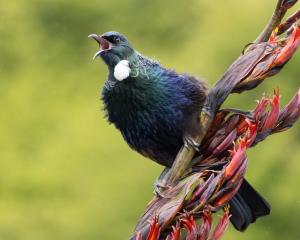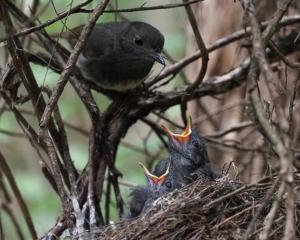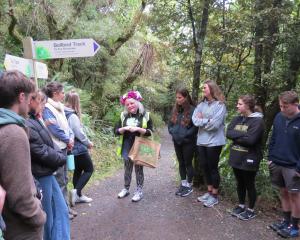Alyth Grant reports on the growth and care of the flax grove near the entrance to Orokonui Ecosanctuary.
Now and again we all need new garments, especially if we are out a lot in wind and weather. So it is with the two symbolic pou (posts) that mark the entrance to the pa harakeke (flax grove) near the entrance to Orokonui Ecosanctuary.
The pou, being made of hard recycled Australian jarrah timber, could not be carved in the usual way, and so were decorated with skirts woven from flax.
Last month Tane Mahuta, guardian of the forest, and Hine-te-iwa-iwa, guardian of the knowledge of forest plants and the art of weaving, were dressed anew.
It was an occasion to celebrate the remarkable growth of the plants and trees in the grove.
Five years ago this area was just an overgrown tangle of Himalayan honeysuckle and broom; today a koru-shaped path leads through thriving ranks of harakeke of varied colour to a wooden platform for weaving, whose shape reflects the web of that first weaver, pukawerewere the spider.
One day, weavers working on the platform will be shaded by the totara tree that has been planted at its centre.
The pa is home to more than 100 varieties of harakeke (Phormium tenax) and wharariki (Phormium cookianum) sourced from Dunedin Botanic Garden and the Rene Orchiston collection.
That makes it a valuable resource that can provide for the specialist needs of weavers. Flax is not just flax! The different cultivars have quite different weaving characteristics.
They are a living cultural treasure handed down through generations of Maori weavers. Many were collected and catalogued by a remarkable Gisborne woman, Rene Orchiston, in the 1940s.
It is not often that so many varieties are found in one place, so the weavers are recording the characteristics as they use them, thus adding to the knowledge about them.
The art of weaving is of great interest to visitors to the ecosanctuary as well. For some larger tour groups, guide Sue Hensley has organised a weaving demonstration as an additional attraction to the guided walk inside the fence.
Some get to make a simple item themselves to take away. Few realise how long it takes to become fully competent weavers, but they leave proudly bearing their own small treasure.
Crosscultural links can become apparent: origami skills proved helpful in working with flax for some Japanese families of Dunedin's ''Kodomo Kai''.
They were given a hands-on demonstration in reward for their volunteer labour in the pa harakeke. They not only deftly made the simple items taught but also added refinements and variations.
Responsibility for the pa is shared by the ecosanctuary and its partner iwi, Kati Huirapa Runaka ki Puketeraki. The plants are available for harvest and use by local weavers, usually after flowering is finished.
Access is open to all, as it is outside the fence of the ecosanctuary. It is a quiet place for contemplation and the enjoyment of the birds that visit it, not just the tui and bellbirds one expects to see among flax: a tomtit is also often to be seen flitting from plant to tree and fernbirds are heard. David Mules, of the Department of Conservation, who has connections to Kati Huirapa, was the instigator and the driving force behind the establishment of the pa harakeke, organising the working-bees needed to clear the site, plan the layout, plant the flax and erect the pou.
When he was transferred to Kaitaia soon after the hard work was done and the pa opened, he left behind detailed information about harakeke, its use and care. Like all gardens the pa requires maintenance.
That too is shared among iwi members, volunteers and staff of the ecosanctuary.
Once a month a group of weavers meets at the ecosanctuary for a ''work and weave'' morning, sharing their skills and company while they work.
They understand perhaps best of all the intimate connection between plant care and the harvesting of the resource for creative use. It is their work that now graces the pou, Tane Mahuta and Hine-te-iwa-iwa.
Alyth Grant is a volunteer at the ecosanctuary and a trustee of the ONHT.
Wild Ways runs on the first Saturday of the month.












